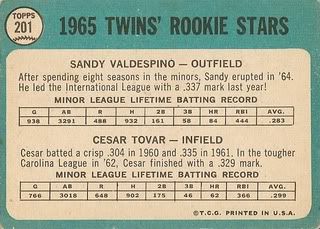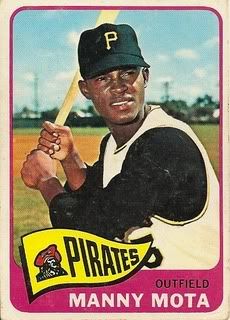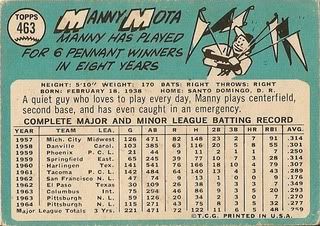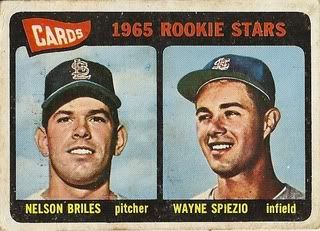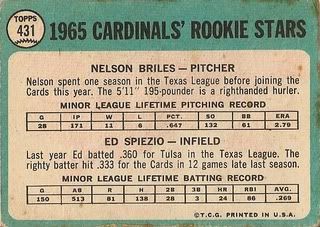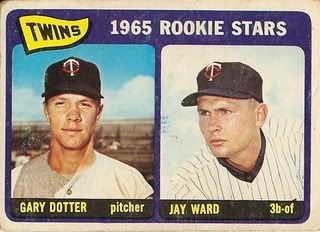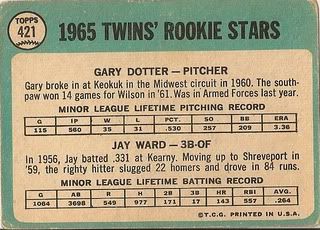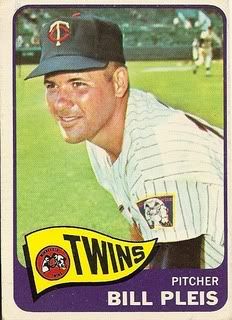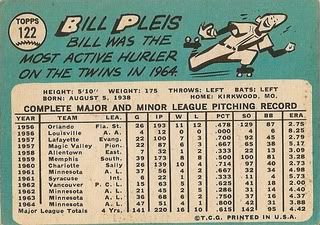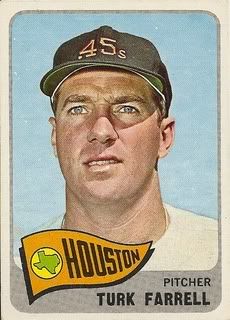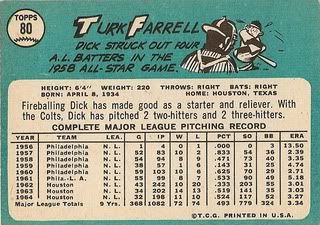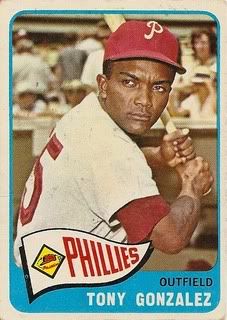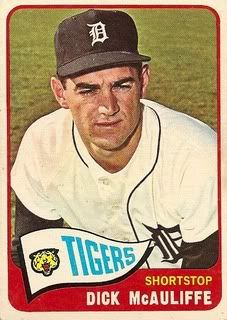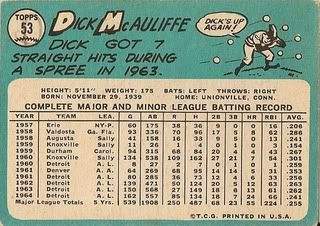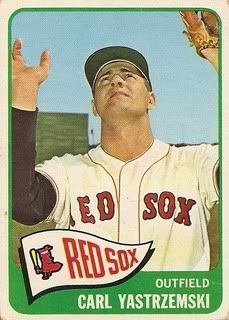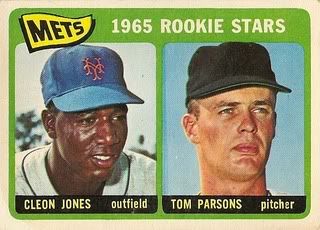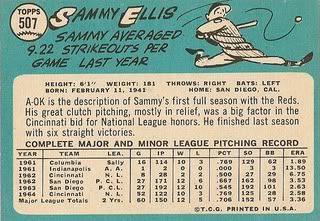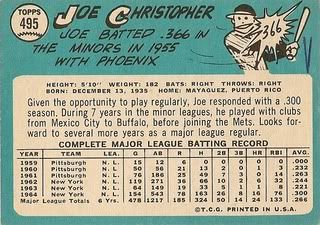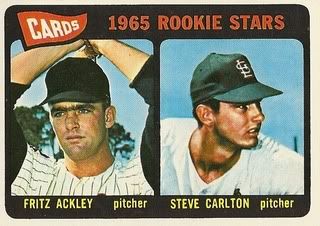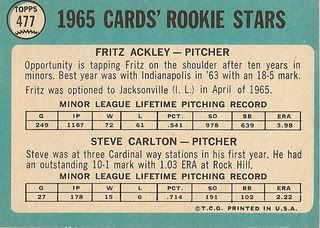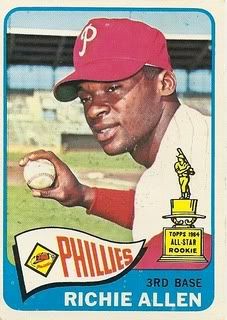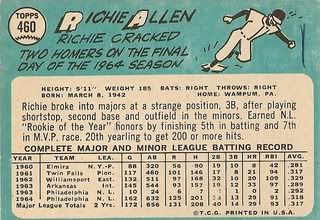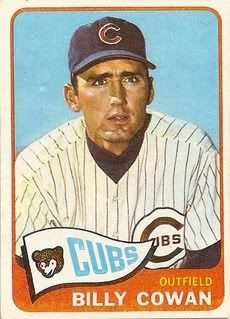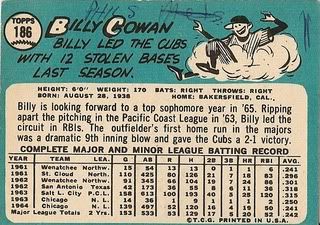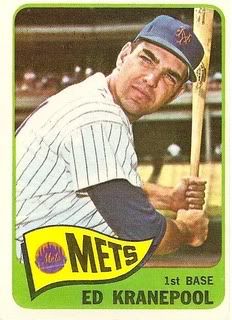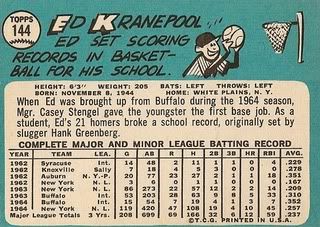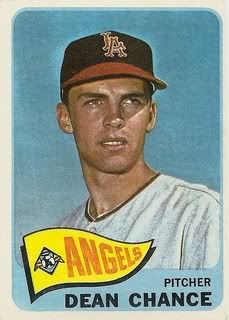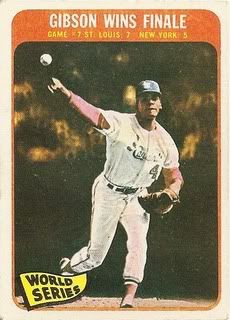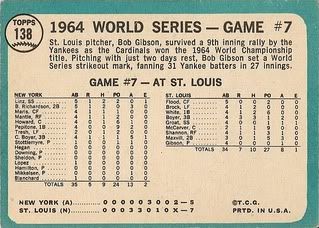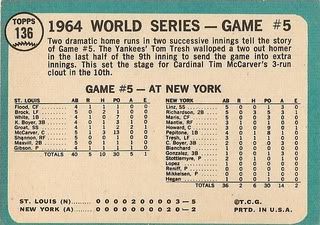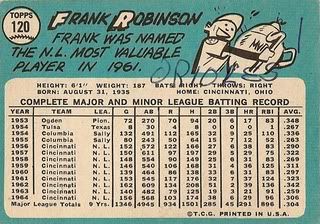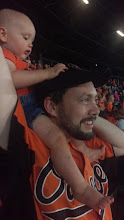
Wow, somebody went overboard in airbrushing Sandy Valdespino's pitcure.
Fun facts about Sandy Valdespino:
-A native of San Jose de las Lajas, Cuba, Sandy signed with the Senators in 1957.
-The diminutive outfielder stood just 5'8" tall and weighed 170 pounds. He got his nickname (he was born Hilario Valdespino) from a minor-league manager, who likened him to the similarly-small ex-Dodger Sandy Amoros.
-He finally got the attention of the big league club in his eighth pro season, when he batted .337 with 51 extra-base hits for the AAA Atlanta Crackers in 1964.
-Sandy reached the big leagues in 1965 at age 26. Each of his first 13 appearances with the Twins came in a pinch-hit capacity, and he reached base in his first four plate appearance. His first start came on
May 19, 1965; he went 3-for-6 with a double and scored one of Minnesota's two 12th-inning runs in a 3-1 win over the Angels.
-The rookie appeared in a career-high 108 games for the American League champs, compiling a .261 average and driving in 22 runs. He appeared in five of their seven World Series games, going 3-for-11 at the plate with a single and a double against Don Drysdale and a pinch single off of Sandy Koufax.
-Both his playing time and his performance waned after that debut season, but teammates later recalled an excellent defensive play he made on
June 18, 1967. Jim Kaat took a 4-0 lead into the bottom of the eighth inning, but the Indians chased him with a pair of run-scoring singles. With two outs and the bases loaded, skipper Cal Ermer pulled a double-switch, inserting Ron Kline to pitch and sending Valdespino to left field. Batter Larry Brown crushed a drive to left, and Sandy sprinted to the fence with his back to the field. He leapt (still not facing the field), dug his spikes into the wall, and snagged the ball over his shoulder in midair to quell the Cleveland rally. Kline closed the game out with a perfect ninth inning.
-The Braves claimed him in the Rule 5 draft after the 1967 season, and he moved frequently for the rest of his career, spending small portions of the following four seasons with the Braves, the Astros and Pilots, the Brewers, and the Royals.
-His final big league exposure was with Kansas City, where he hit .317 in 18 games in 1971. In parts of 7 seasons he batted .230 with 7 home runs and 67 RBI.
-Sandy's final big league home run, on
September 13, 1971, tied a game with the Athletics at 1-1 in the fourth inning and spoiled a shutout bid by Catfish Hunter. The future Hall of Famer would have to pitch 10 innings that day to earn his 20th win of the season by a 2-1 margin.
-At last check, the now-72-year-old Valdespino was living in Las Vegas, NV.
Fun facts about Cesar Tovar:
-Cesar was born in Caracas, Venezuela, and signed with Cincinnati as a teenager in 1959. He would later become the ninth Venezuelan to debut in MLB.
-Though he hit for average and power and drew walks in the minors, he was blocked at the major-league level by several talented young Reds. A December 1964 trade to the Twins for pitcher Gerry Arrigo was his big break.
-He had a few brief trials in Minnesota in 1965, and became a super-utility player the following year, batting .260 in 134 games and seeing significant time at second base, shortstop, and center field, with an occasional appearance in left field. The following year he set a big league record by playing in all 164 Twins games (including two ties), and batted .267 with 32 doubles, a team-best 19 steals, and 98 runs scored. He denied A.L. Triple Crown winner Carl Yastrzemski a unanimous MVP vote, as Minneapolis sports writer Max Nichols cast a lone first-place vote for the versatile Tovar.
-Cesar gained notoriety by becoming the second player to ever log time at each of the nine defensive positions in a single game. He performed the feat on
September 22, 1968, in a 2-1 win over the A's. He pitched the first inning, and coincidentally faced Bert Campaneris (his predecessor in the 9-in-1 club) to lead off the game. He retired Campy on a foul popup, and followed with a strikeout of Reggie Jackson. He pitched a scoreless inning, working around a walk to Danny Cater. At bat, he went 1-for-3 with a walk, a steal, and a run scored. Check out the box score to see all of the manuevering done by Cal Ermer, including appearances by Rod Carew at shortstop and Graig Nettles in center field!
-
May 18, 1969 saw Tovar and Carew set a major league record with five stolen bases in a single inning. Tovar led off the bottom of the third by drawing a walk from Mickey Lolich, distracting him sufficiently to take second on a balk, and then stealing third and home. Carew walked, took second as part of a double-steal on the Tovar swipe of home, and then stole third and home with Harmon Killebrew at the plate. Lolich and Tigers catcher Bill Freehan got the last laugh, keeping Minnesota off the scoreboard for the rest of the game and winning 8-2.
-His career year was 1970, when he led the American League with 36 doubles and 13 triples and batted .300. He paced the Twins with 30 steals and 120 runs scored, and also set career highs with a .356 on-base percentage and .442 slugging.
-Cesar built upon his successes by topping the A.L. with 204 hits in 1971, accumulating a .311 average.
-He showed a flair for the dramatic on
September 19, 1972. Batting in the bottom of the ninth with two outs, a runner on first, and the game tied at three, he needed a home run for the cycle. Tovar deposited a Paul Lindblad pitch into the seats for a walkoff two-run homer! Only four other players have hit a game-ending home run to complete the cycle: Ken Boyer, George Brett, Dwight Evans, and Carlos Gonzalez.
-At the tail end of his career, he spent time with the Phillies, Rangers, Athletics, and Yankees. New York released him in 1976, capping his big league numbers at a .278 average, 46 home runs, 435 RBI, and 226 steals in parts of 12 seasons.
-Cesar returned to Venezuela after his retirement and later managed his home country in 1990's Baseball World Cup, but they lost seven of their eight games in the tournament. He died of pancreatic cancer at age 54 in 1994, and was posthumously inducted into the Venezuelan Baseball Hall of Fame in 2003.
